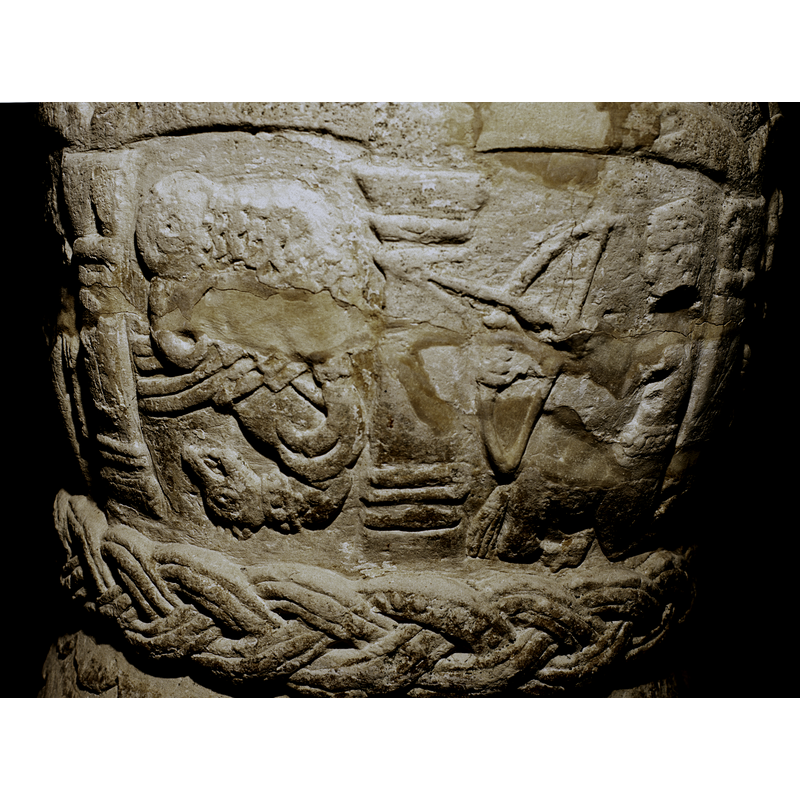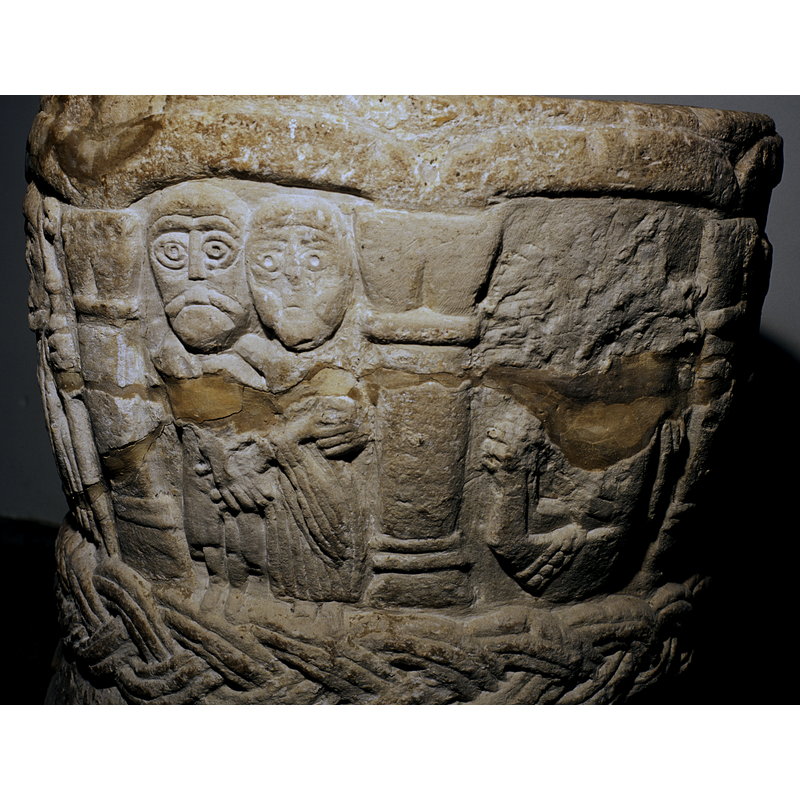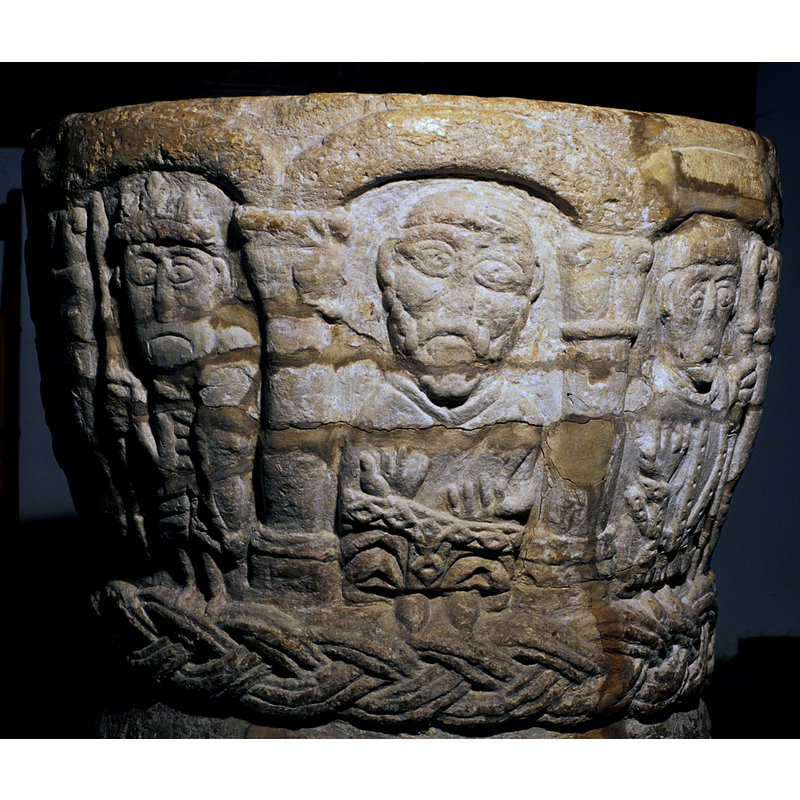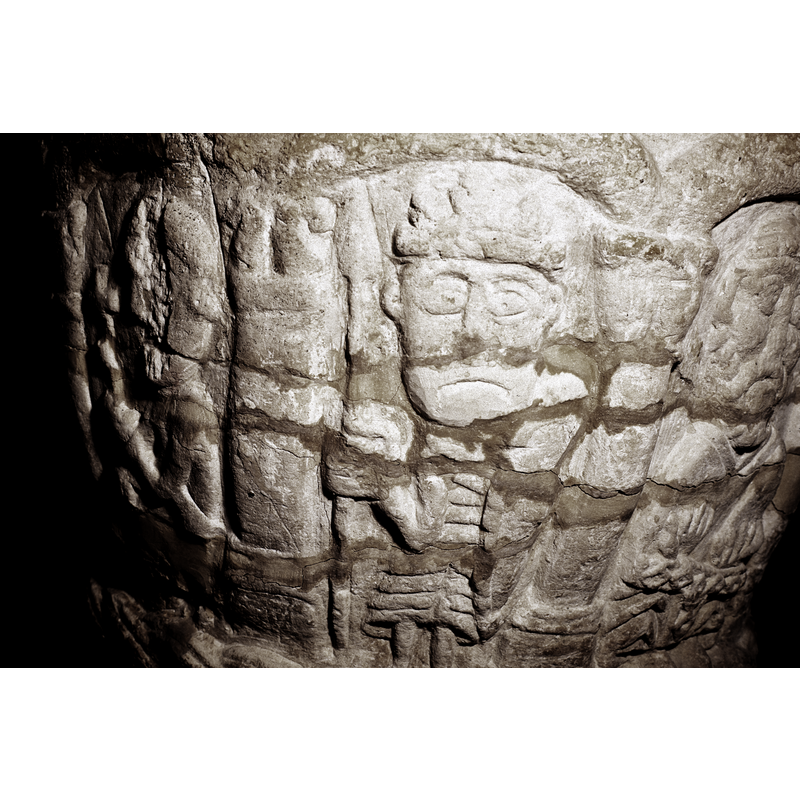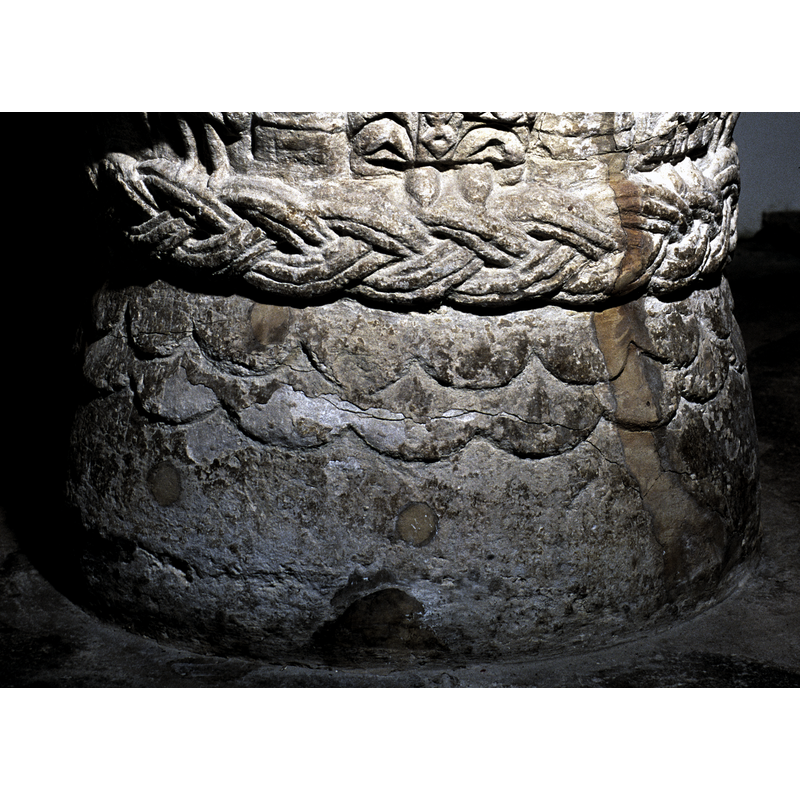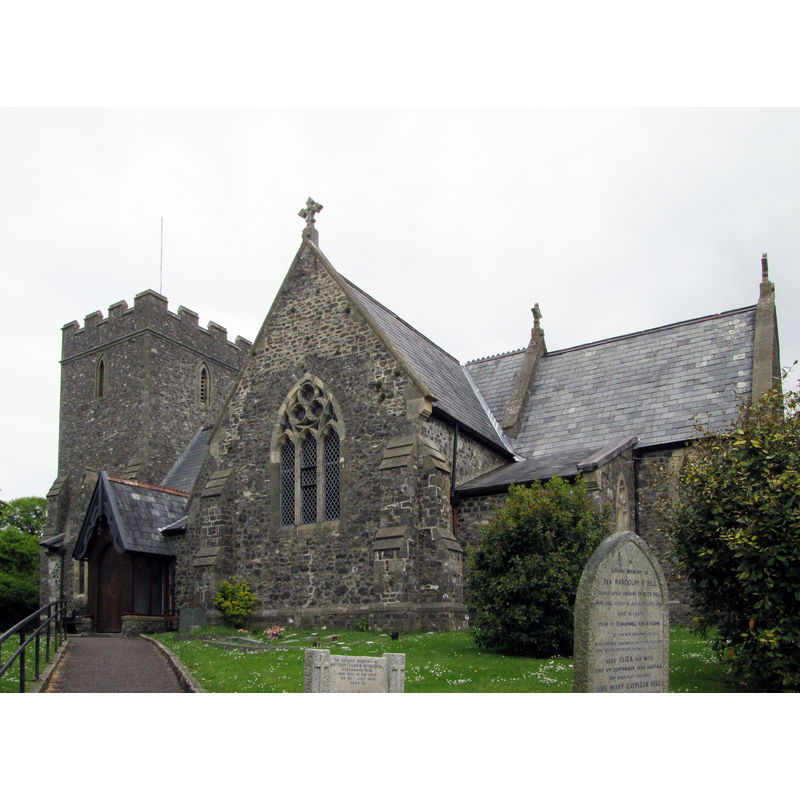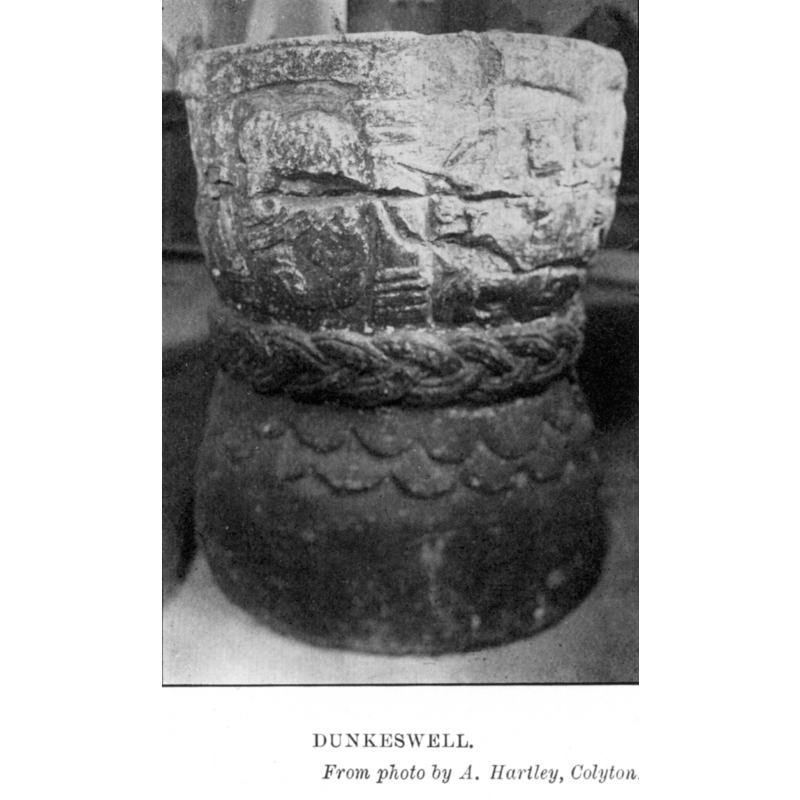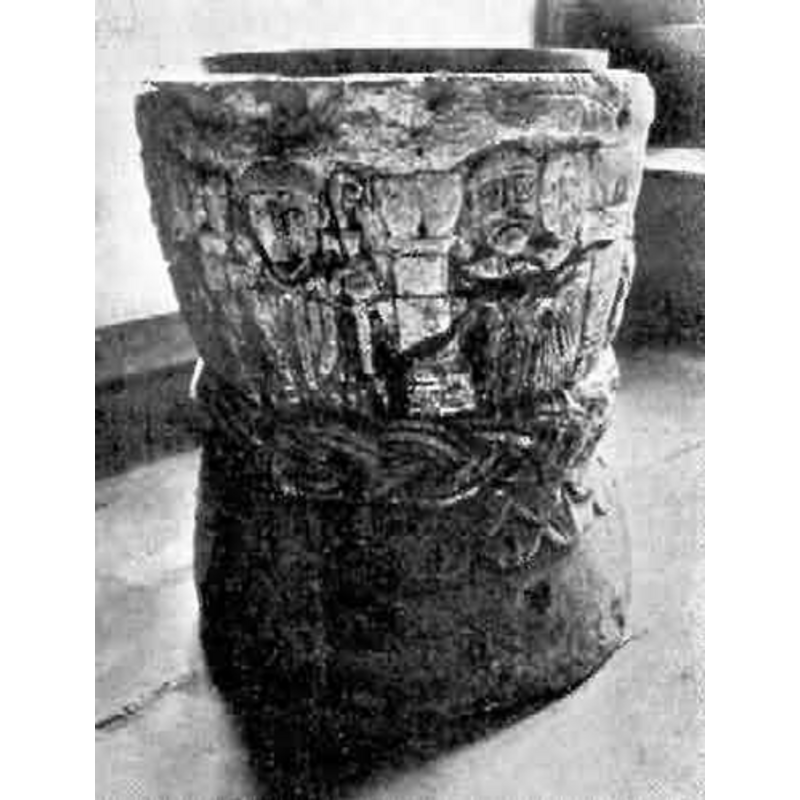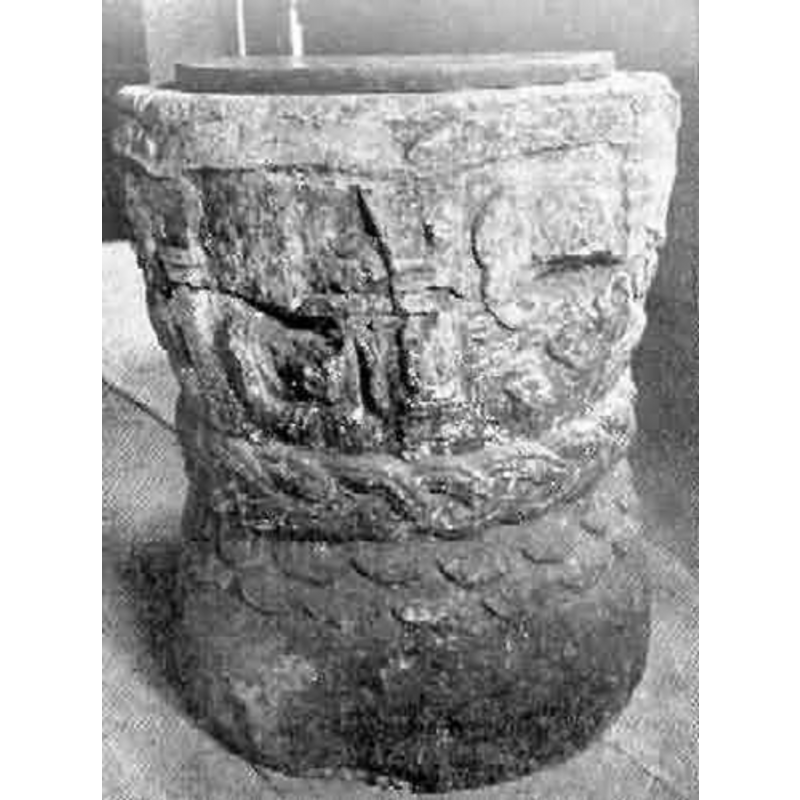Dunkeswell / Doducheswelle
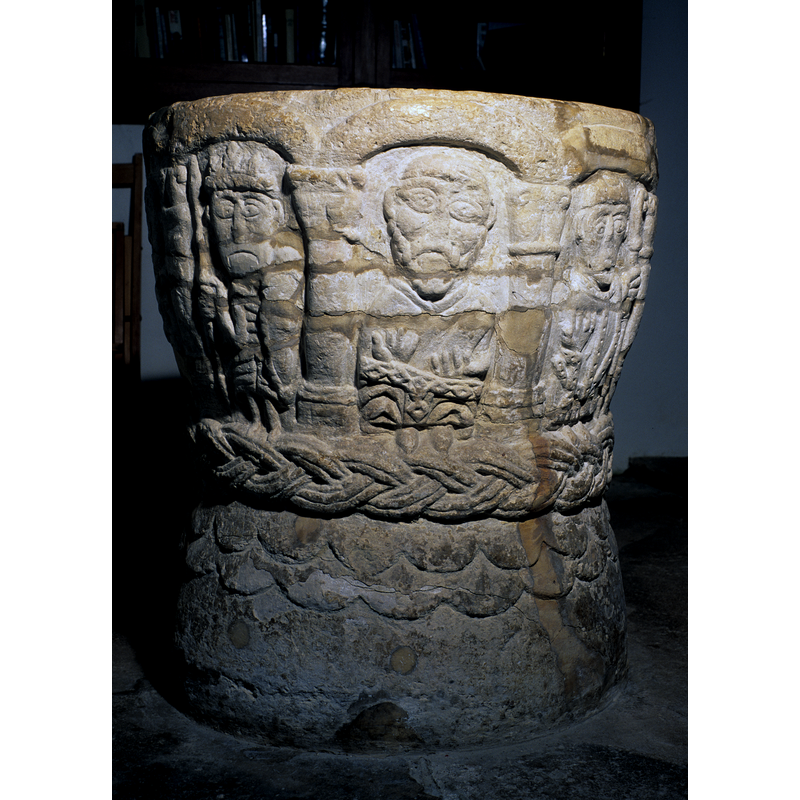
Image copyright © Baptisteria Sacra Index, 2023
Results: 18 records
animal - fabulous animal or monster - centaur - with bow and arrow
animal - mammal - elephant?
Scene Description: In 1997 there was a fire which destroyed much of the church and part of this section on the font. Some have identified the animal at the top as an elephant; the animal below appears to be on the side or upside down; there is a broad column between the animals on the left and the archer on the right but the tip of the arrow is between the column and the viewer
Copyright Statement: Image copyright © Baptisteria Sacra Index, 2023
Image Source: digital image of a photograph taken 27 July 1998 by BSI
cleric - bishop - wearing chasuble - with staff
cleric - holding processional cross
design element - architectural - arcade - round arches - columns with capitals and bases - 8
Scene Description: some of the arches are almost flat; all the capitals are individually decorated and of varied shapes, some double; bases of the columns are chiefly round mouldings
Copyright Statement: Image copyright © Baptisteria Sacra Index, 2023
Image Source: digital image of a photograph taken 27 July 1998 by BSI
design element - motifs - braid - 3-strand
design element - patterns - scalloped
human figure - male - seated
Scene Description: in the centre arch; one source suggests an identification as Peter ad Vincula but the 'chains' appear to be a fancy belt instead; the man is bearded and appears to be tonsured as well
Copyright Statement: Image copyright © Baptisteria Sacra Index, 2023
Image Source: digital image of a photograph taken 27 July 1998 by BSI
human figure - male - wearing crown - king? - with spear and shield
human figure - male and female - embracing
unidentified
Scene Description: the right panel here, to the right of the embracing pair, is of the most damaged of this font; what remains in the bottom half has been identified in differemt sources [cf. FontNotes] as an elephant, the prow of a ship, etc.; what remains now suggests more a very strong arm girdled by a ring and wielding an object that is no longer discernible, but the forarm and the closed hand are.
Copyright Statement: Image copyright © Baptisteria Sacra Index, 2023
Image Source: digital image of a photograph taken 27 July 1998 by BSI
view of base
view of church exterior - southeast view
view of church interior - nave - looking east
view of font
view of font - east side
view of font and cover
INFORMATION
FontID: 00791DUN
Object Type: Baptismal Font1
Church/Chapel: Parish Church of St. Nicholas
Church Patron Saints: St. Nicholas of Myra
Church Location: 1 Tencery Orchard, Dunkeswell, Devon EX14 4RE, United Kingdom
Country Name: England
Location: Devon, South West
Directions to Site: Located WSW of Luppitt [with another very interesting font], 9 km NNW of Honiton
Ecclesiastic Region: Diocese of Exeter
Historical Region: Hundred of Hemyock [in Domesday]
Font Location in Church: Inside the church
Century and Period: 11th - 13th century, Pre-Conquest? / Norman?
Cognate Fonts: [cf. FontNotes]
Credit and Acknowledgements: We are grateful to Dr. Roger Peters, of www.wissensdrang.com, for his permission to use the transcription of and images from Stabb (1908)
Church Notes: medieval church totally re-built mid-19thC
Font Notes:
Click to view
There is an entry for Dunkeswell [variant spelling] in the Domesday survey [http://domesdaymap.co.uk/place/] [accesed 1 October 2016], but it mentions neither cleric nor church in it. Lewis' Dictionary of 1848 notes: "The church has a font which is very ancient, and ornamented with figures supposed to represent Bruere [i.e., William Bruere, ca. 1201, founder of a White monks abbey nearby] and his wife". Listed in Cox & Harvey (1907) as a baptismal font of the Norman period. Described and illustrated in G. Browne's 'On a supposed inscription upon the font at Wilne', Derbyshire Archaeological Journal (Vol. 7, pp 185-194, illust.): "The bowl of the font in Wilne church is made from part of a circular tapering pillar… the carving is wrong-side up. It was broken into several pieces in the disastrous fire in March 1917.. Although the fragments have been carefully pieced together… The bowl is 23 in. high and 82 in. in girth at the top, tapering to 77 in… Late and decadent Anglian". Described and illustrated in Bond (1908) as one of "a set of sculptured fonts which have been credited with undue antiquity, owing to the rudeness or uncouthness or their ornament; but it by no means folows that what is archaic is always ancient." Described and illustrated in Stabb (1908), who has some interesting suggestions about the identification of some of the figures [cf. also Clarke, infra]: The font "is circular in shape, decreasing slightly in size at the centre, which is surrounded by a twist pattern, not cable moulding; beneath the twist is a scallop pattern. The upper portion of the font is divided into eight panels; in one there is a figure of a bishop arrayed in chasuble and holding a staff [...]; next to this is another figure, apparently in chains; there are also represented a king, a lord and a lady, and an elephant. It is difficult to date the font, it might be Norman, but if the elephant was sculptured from life the font cannot probably be earlier than the 13th century as, according to Matthew Paris [ca. 1200-1259], the first elephant was seen in England in 1255, when King Henry III [r. 1216-1272] received one from Louis IX [r. 1226-1270] of France. It has been suggested that the lord and the lady may be intended for Lord William de Briwere and his wife; he was the founder of Dunkeswell Abbey, died in 1226, and was buried before the high altar of the Abbey church. The presence of an elephant on a font is appropriate, as there was an ancient belief that the elephant brought forth her young in the water, and the animal thus became a symbol of the new birth in the water of baptism. The carvings on the font are much worn and difficult to make out; the elephant will be found on the west side." Described and illustrated in Clarke (1914) who describes the program [L->R] thus: 1)bishop wearing a chasuble and holding a pastoral staff; 2)a man and a woman; 3)part of a boat with a high prow, emblem of the Church or Noah's Ark, symbol of baptism; 4)elephant covered with scales, possibly by association of ideas with the rhinoceros; 5)an archer shoots an arrow at the elephant; 6)a man holding a cross-handled sword; 7)a king, crowned, with sword and shield; 8)a man in chains. Clarke suggests that the last three figures may represent St Peter ad vincula (Acts XII), with no. 6 being a guard and no. 7 Herod, and also, possibly, no. 2 representing "St. Peter after his deliverance, speaking to the damsel called Rhoda". Clarke (ibid.) debates between the identification of the bishop figure as St. Nicholas, bishop of Myra -to whom the church is dedicated- or simply as a representation of the authority of the Church. On-site notes: eight niches surround the bowl [L->R]: North side, a couple (male and female) are embracing and holding hands, second niche [L->R] unidentifiable (apparently it may have been an elephant before the fire); 3rd niche two animals with one upside-down; 4th arch has a centaur (body facing right and looking backward); 5th, bust of a figure holding a cross-staff in left hand; 6th, figure holding lance and shield and is crowned; 7th, figure full-frontal, arms crossed; 8th, figure is a bishop holding a staff in left hand. The Notes & Queries of Nov. 10, 1928, notes: "The church has a font, which is very ancient and ornamented with figures supposed to represent Bruere and his wife." Monolithic font with central cable & a row of scalloping; lined with lead and has a central drain. In 1997 there was a fire in the church which caused much damage to the interior and also to the font, which needed repairs to bowl and base. Pevsner (1952) writes: "Norman font, circular with whole figures in arcades of columns and very depressed arches. Amongst the figures a bishop, a doctor, an elephant. What can their combined meaning be? The craftsmanship very crude." The entry for Tortington (West Sussex) in the CRSBI (2016) gathers information for several sources that favour the existence of a workshop in Dorset ca. 1150 responsible for the manufacture of the fonts at Torrington, Bishop's Teignton, Honiton, South Milton, Dun[kes?]well, Luppitt and Blackhawton. The entry for this church in English Heritage [Listing NGR: ST1414107807] (1988) notes: "The only feature older than the 1860's is the Norman font. It is crudely carved but a most unusual example; a girdled font with a plait around below which are 2 rows of scallop ornament and above which an arcade of columns with carved capitals and segmental arches. The panels are all different and feature in order a bishop with crozier, a man and a woman, a sailing boat, a fabulous monster looking somewhat like an elephant, an archer shooting towards the monster, a man with a cross-handled sword, a king crowned with sword and shield, and a man in chains." There is an article that discusses the possiblity of an inscription on this font: G. Browne's 'On a supposed inscription upon the font at Wilne', in the Derbyshire Archaeological Journal (Vol. 7, pp 185-194, illust.)
COORDINATES
Church Latitude & Longitude Decimal: 50.863318, -3.220526
Church Latitude & Longitude DMS: 50° 51′ 47.95″ N, 3° 13′ 13.9″ W
UTM: 30U 484480 5634649
MEDIUM AND MEASUREMENTS
Material: stone, limestone
Number of Pieces: one
Font Shape: hemispherical (mounted) -- chalice-shaped
Basin Interior Shape: round
Basin Exterior Shape: round
Rim Thickness: 8.5 - 10 cm*
Diameter (inside rim): 46 cm* / 47.5 cm**
Diameter (includes rim): 64-66 cm* / 70 cm** / 66.30 cm***
Basin Depth: 25 cm*
Height of Basin Side: 38 cm* / 40 cm**
Height of Base: 38 cm* / 40 cm** / 58.42 cm***
Font Height (less Plinth): 76 cm* / 75 cm**
Notes on Measurements: * BSI on-site / ** measurements given in inches in Clarke (1914: 436) / *** in inches in Browne [cf. FontNotes]
INSCRIPTION
Inscription Notes: [cf. FontNotes]
LID INFORMATION
Date: modern?
Material: wood
Apparatus: no
Notes: plain flat wooden lid shown in Clarke's illustrations
REFERENCES
Bond, Francis, Fonts and Font Covers, London: Waterstone, 1985 c1908
Clarke, Kate M., "The baptismal fonts of Devon -- Part I", 45, Report and Transactions of the Devonshire Association for the Advancement of Science, Literature and Art, 1913, pp. 314-329; p. 318
Clarke, Kate M., "The baptismal fonts of Devon -- Part II", 46, Report and Transactions of the Devonshire Association for the Advancement of Science, Literature and Art, 1914, pp. 428-435; p. 431-432, 436 and ill. on p. opp. p. 430
Cox, John Charles, English Church Furniture, New York: E.P. Dutton & Co., 1907
Lewis, Samuel, A Topographical Dictionary of England, Comprising the Several Counties, Cities, Boroughs, Corporate and Market Towns, Parishes, Chapelries, and Townships, and the Islands of Guernsy, Jersey, and Man, with Historical and Statistical Descriptions [...], London: S. Lewis, 1831
Pevsner, Nikolaus, South Devon, Harmondsworth: Penguin Books, 1952
Ransford, Alfred, "De Lancaster of Kendal", 1928, 10 November, Notes and Queries, 1928, pp. 328-332; p. 328
Stabb, John, Some old Devon churches, their roods, pulpits, fonts, etc., London: Simkin, [et al.], 1908-1916
